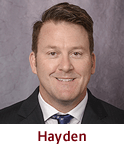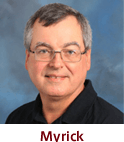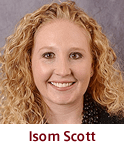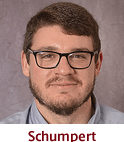Sometimes, homework is taking a virtual reality tour of a prison.
Or making a music video about cellular respiration. Or visiting two historic sites and comparing them.
Four College of Arts and Sciences faculty members were honored last week for the way they use these activities and others to enhance student learning at the University of South Carolina. The Office of the Provost recognized them with the 2020 Garnet Apple Award for Teaching Innovation. Two faculty members from other colleges on campus were honored, too.
The Arts and Sciences faculty members described how their active approaches to teaching have helped students learn more and think critically.
Hayden Smith, Criminology and Criminal Justice
Hayden Smith says he is a “lifelong teacher” experiencing a revolution.
His research on mental illness in the criminal justice system has taken him to places his students can’t go, like maximum-security units where he wears a flak jacket and helmet with facemask for protection. But his students need to see these areas for themselves, he says. “Without experiences, criminal justice students are apt to do what the general public does ― that is, to construct knowledge about crime based on myths and media.”
Smith solved that problem with virtual reality. He attended a Center for Teaching Excellence workshop on virtual reality teaching. He also collaborated with other Arts and Sciences faculty through the college’s Incubator for Teaching Innovation, for which he is an ambassador. The result is a series of virtual reality experiences that allow students to see the justice system for themselves. They can take a bus trip with people going to see inmates, or they can learn about the lives of pregnant inmates at a women’s prison.
“Students can experience the symptoms of mental illness before going into a virtual ‘lock down’ unit where they can get a sense of the lack of space and other physical constraints,” Smith says. “It is one thing to explain what isolation does to an inmate with mental health issues, it is another thing entirely to have students see for themselves in a safe and realistic manner.”
Students love the virtual experiences, he says. He has collected feedback from nearly 400 students. “They universally expressed the connections that they made between the classroom and the real world,” he says.
Michael “Micky” Myrick, Chemistry and Biochemistry
 Most chemistry lab assignments are loaded with information, including background on
the theory and experimental methods involved and suggestions of how to use the results.
Professional chemists do not have that luxury, though.
Most chemistry lab assignments are loaded with information, including background on
the theory and experimental methods involved and suggestions of how to use the results.
Professional chemists do not have that luxury, though.
Micky Myrick and his colleagues have found a way to bridge the academic lab with the professional labs where their graduates will work. “A few years ago we introduced a couple of new laboratories with the intention of telling them very little of what to do with their data,” he says.
In these lab assignments, students are told that they will use nuclear magnetic resonance spectroscopy (which they learn about as sophomores) to study a molecule, and that thermodynamics (which they learn about as juniors) will come into play. “Then we let them figure it out for themselves, do all the literature research and figure out how to treat and plot the data to give a meaningful result,” Myrick says. “This is sort of a ‘capstone’ experiment for the laboratory," and it's about as close to real-life chemistry as possible.
“I think it is very effective at fully engaging their skill set and combing back through what they’ve learned through multiple courses,” Myrick says.
Deena Isom Scott, African American Studies, Criminology and Criminal Justice
 For Deena Isom Scott, talking about race and social justice is not enough.
For Deena Isom Scott, talking about race and social justice is not enough.
“I believe it is important to get outside of the classroom to engage with the real world,” she says. “I try to incorporate trips throughout the semester that will take students to places they have likely never been or have never considered with a critical lens.”
She took two classes to Charleston, South Carolina, to visit Boone Hall Plantation and the Old Slave Mart Museum. “Students compared how the stories and experiences of enslaved people in the antebellum South were portrayed at these vastly different places, critically assessing the authenticity and completeness of the narratives,” she says.
This fall, she will take her “Miscarriages of Justice” class to the Legacy Museum and National Memorial for Peace and Justice in Montgomery, Alabama, where they will learn about lynching and other terrors faced by African Americans. The class is part of a College of Arts and Sciences Theme Semester on justice.
These field trips are more than tourist opportunities. “Students partake in critical reflections of the real world,” Isom Scott says. “They learn about the complexities and intricacies of history and today and gain a new critical lens through which to see and interact with the world.”
Charles “Andy” Schumpert, Biological Sciences
 Music meets metabolism in Andy Schumpert’s biology classes.
Music meets metabolism in Andy Schumpert’s biology classes.
He challenges students to make music videos about concepts they study in class or lab. “The last class session of the semester, we play these videos and the students absolutely love it,” he says. “It’s a great review for the final exam.”
He also builds other activities into class to keep students moving and thinking. For example, they might pause to diagnose a mystery illness or break into groups to try using molecular concepts to solve scientific problems. He also has incorporated 360-degree video and virtual reality into some courses.
“Active learning has brought out the best in my students each semester,” he says. “After the first few activities, they’re hooked! Instead of us going through PowerPoint lectures all class, students get to apply their knowledge in these active learning activities, and we’ve seen overall class performance improve immensely.”